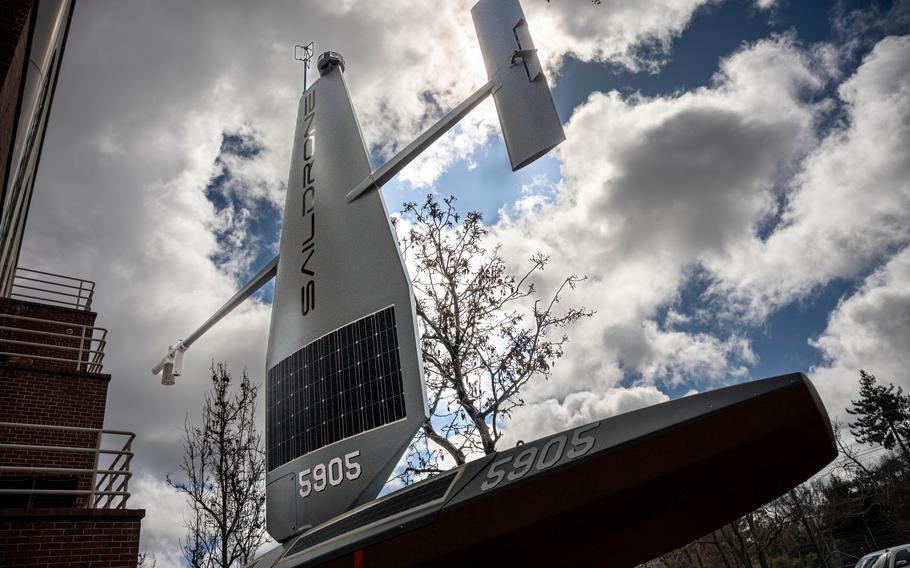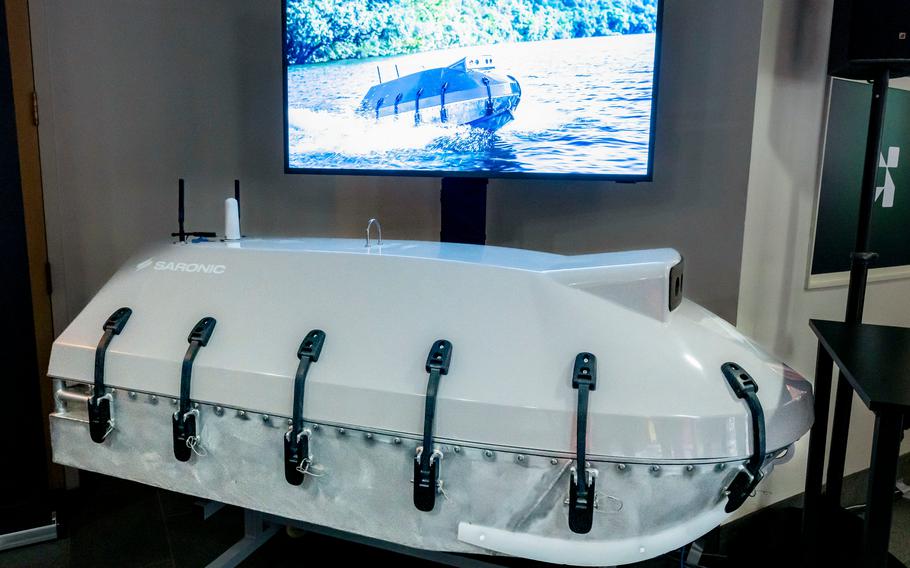
A Saildrone on display outside a conference hosted by Palantir. (David Paul Morris/Bloomberg)
Blue Water Autonomy, a startup that’s less than a year old, is preparing to build a hulking, 100-foot ship. Co-founded by Navy veterans and former tech executives, the company has designed the vessel to travel thousands of miles for months at a time over the open ocean — without a captain or crew.
Boston-based Blue Water has about 10 employees and $14 million in new funding. Its goal of building an autonomous ship that can carry 100 tons — about 50 cars — represents the outsized seafaring ambition of a group of startups working to release thousands of uncrewed vessels into and under the water.
In the last year, investors including Founders Fund, Andreessen Horowitz and 8VC have together plowed billions into companies using artificial intelligence, autonomy software and other technology with naval applications. For example, in February, Saronic Technologies raised $600 million to mass-produce autonomous vessels at a new shipyard. Venture-backed Saildrone Inc. says its fleet of sailing vehicles has traversed 1.6 million nautical miles. Earlier this week, Saildrone set up a subsidiary in Denmark as a step toward expanding operations to the Baltic Sea.

The Saronic Technologies Spyglass Autonomous Surface Vessel watercraft. (David Paul Morris/Bloomberg)
Also this week, weapons startup Anduril Industries Inc. unveiled a torpedo-like autonomous drone called Copperhead, with the tagline: “Whoever commands the sea commands the world.”
Building ships has become an increasingly urgent national priority. On Wednesday, President Donald Trump signed an executive order seeking to revive the industry in the US. The president will also dispatch Elon Musk’s efficiency squad to investigate how the US Navy fell so far behind in turning out vessels. In January, Ambassador Katherine Tai said that the US builds fewer than five ships a year, while China constructs more than 1,700.
Blue Water is taking the country’s slump in shipbuilding seriously. Chief Executive Officer Rylan Hamilton compared the company’s mission to the Liberty ships the US made during World War II. Blue Water’s vessel is designed for mass production, he said, with construction taking months rather than years. “We’ll need to deliver these at scale,” Hamilton said. “The Navy needs to make hundreds of these.”
Rising global tensions with China and Russia have fueled a larger rekindling of Silicon Valley’s interest in defense technology. In the US, the defense sector is led by companies like SpaceX and Palantir Technologies Inc., which have commanded big government contracts after years trying to break into the insular world of US defense and military sales. Now, SpaceX is the world’s largest startup, and Palantir’s stock has climbed about 1,000% in the last two years. Private investors have taken note: Venture capital firms have plowed more money into US defense tech startups since 2021 than in the entire previous decade.
“We love this stuff,” said Seth Winterroth, a partner at Eclipse Ventures, which backed Blue Water, citing the recent upswell of industrial and defense companies. “It’s music to our ears to see a resurgence of this nationally.”
There are a wide variety of nautical drones currently in development, ranging from small swimming swarms to Blue Water’s 100-foot vessel. Most versions of the technology rely on AI, and many are equipped to carry military supplies while navigating through contested waters without GPS or communications. At Saildrone, for example, dozens of solar- and wind-powered drones that look like model sailboats are now operating in the Caribbean to deter illegal immigration and drug smuggling.
Another company, Vatn Systems, is building small AI-powered underwater vehicles designed to move in swarms of hundreds at a time. Founded in 2023, the company emerged from stealth last year with backing form the CIA venture unit IQT, and currently operates about a dozen of its 5-foot-long, 6-inch-around drones, which can carry supplies 1,000 miles without a GPS connection. It plans to deliver dozens more vehicles by the end of the year, and ultimately produce thousands.
At Anduril, autonomous Copperhead drones will sit inside larger uncrewed underwater vessels that perform tasks like reconnaissance, mapping and carrying munitions. The startup last summer said it would be capable of producing 200 of its Dive-LD vehicles annually at a new facility in Rhode Island.

The Anduril Dive-LD autonomous underwater vessel in 2023. (Kyle Grillot/Bloomberg)
Hamilton, a US Navy veteran, started Blue Water after co-founding robotic startup 6 River Systems, and previously worked at Amazon.com Inc. The startup is co-founded by Austin Gray, also a Navy veteran, and Scott Miller, an investor and former vice president of engineering at iRobot Corp.
Hamilton described Blue Water’s vessel as “multi-mission,” working in areas with contested logistics to carry supplies, conduct surveillance or transport munitions payloads. During the next six to 12 months, Blue Water will continue demonstrating its systems’ capabilities while determining whether to build its own shipyard or to partner with one of dozens of underused existing ones currently making ferries, tugboats and other vessels.
An open question for companies like Blue Water is whether there will ultimately be a large enough market for their wares. Major US military contracts are famously difficult to get for new companies. Meanwhile, the Navy, which has long sought to increase its autonomous fleet, sliced its own research and development spending by 4.8% this fiscal year, with just $172 million going to unmanned surface vehicles and $192 million to unmanned underwater vehicles.
The technical challenges are also significant. Saltwater, extreme temperatures and lightning storms are the norm in open water passage — and often regular ships must make repairs as vessels are underway. Ensuring all those systems — from fuel pumps to sensors — operate seamlessly without humans will be a high bar.
“There is no room for error,” Hamilton said. “The last thing the Navy needs is a dead ship in the middle of the Pacific Ocean.” The next step for the company will be building a prototype and attempting a voyage. “For the Navy, seeing is believing,” he said.